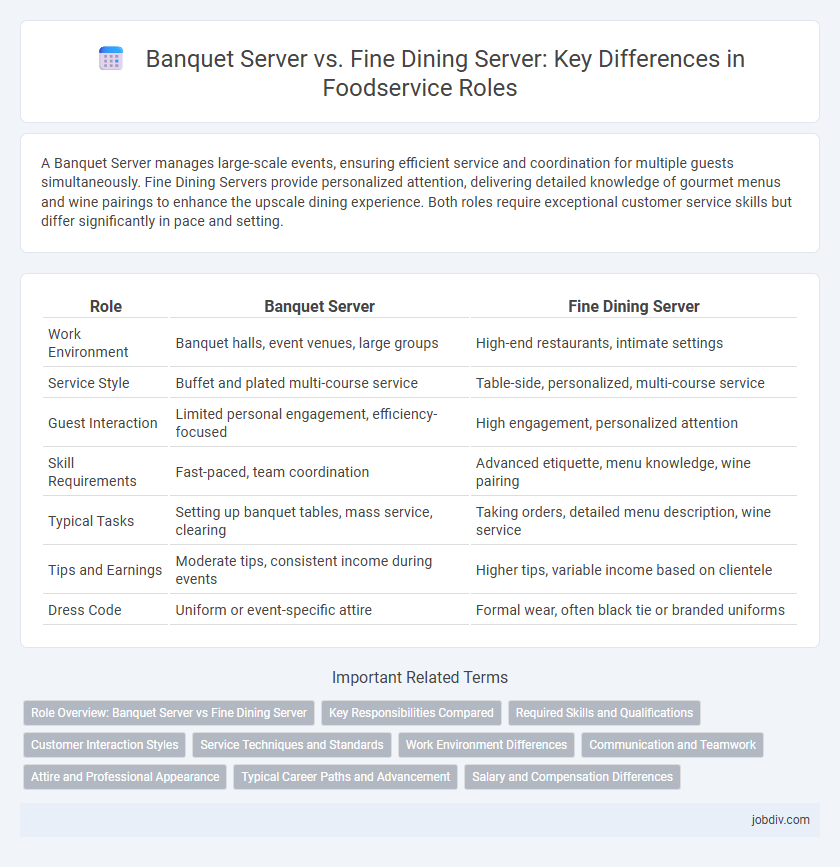A Banquet Server manages large-scale events, ensuring efficient service and coordination for multiple guests simultaneously. Fine Dining Servers provide personalized attention, delivering detailed knowledge of gourmet menus and wine pairings to enhance the upscale dining experience. Both roles require exceptional customer service skills but differ significantly in pace and setting.
Table of Comparison
| Role | Banquet Server | Fine Dining Server |
|---|---|---|
| Work Environment | Banquet halls, event venues, large groups | High-end restaurants, intimate settings |
| Service Style | Buffet and plated multi-course service | Table-side, personalized, multi-course service |
| Guest Interaction | Limited personal engagement, efficiency-focused | High engagement, personalized attention |
| Skill Requirements | Fast-paced, team coordination | Advanced etiquette, menu knowledge, wine pairing |
| Typical Tasks | Setting up banquet tables, mass service, clearing | Taking orders, detailed menu description, wine service |
| Tips and Earnings | Moderate tips, consistent income during events | Higher tips, variable income based on clientele |
| Dress Code | Uniform or event-specific attire | Formal wear, often black tie or branded uniforms |
Role Overview: Banquet Server vs Fine Dining Server
Banquet servers specialize in efficiently serving large groups during events, ensuring timely delivery and maintaining uniform presentation across multiple courses. Fine dining servers provide personalized service, demonstrating in-depth menu knowledge and attentiveness to individual guest preferences, enhancing the upscale dining experience. Both roles require excellent communication skills, but banquet servers prioritize speed and coordination, while fine dining servers focus on detail and customer engagement.
Key Responsibilities Compared
Banquet servers primarily manage large events by setting up tables, serving pre-plated or buffet-style meals, and efficiently coordinating service for groups, ensuring timely food delivery and refills. Fine dining servers provide personalized, detail-oriented service including menu knowledge, wine pairing, and course timing to enhance the guest experience in an upscale environment. Both roles require excellent customer service skills, but banquet servers focus on volume and speed, while fine dining servers emphasize attentiveness and refined presentation.
Required Skills and Qualifications
Banquet servers require strong multitasking abilities and endurance to manage large events with fast-paced service, often needing skills in teamwork and crowd management. Fine dining servers must possess in-depth knowledge of gourmet cuisine, wine pairings, and impeccable customer service skills, emphasizing attention to detail and refined communication. Both roles demand professionalism and a polished appearance, but fine dining servers typically require formal training or certifications in hospitality.
Customer Interaction Styles
Banquet servers engage with large groups, maintaining efficiency and facilitating smooth service through clear, brief interactions to accommodate event pacing and guest turnover. Fine dining servers prioritize personalized, attentive communication, offering detailed menu knowledge and tailored recommendations to enhance the guest's culinary experience. Both roles require professionalism, but banquet servers emphasize speed and coordination, while fine dining servers focus on creating a memorable, customized dining atmosphere.
Service Techniques and Standards
Banquet servers follow standardized service techniques designed for efficiency and consistency during large events, focusing on timely delivery, buffet management, and coordinated teamwork to serve high volumes of guests. Fine dining servers employ highly personalized service standards, utilizing precise plating knowledge, extensive menu expertise, and attentive table-side interactions to provide a refined and memorable guest experience. Both roles demand professionalism, but banquet service prioritizes speed and uniformity, whereas fine dining emphasizes attention to detail and individualized guest care.
Work Environment Differences
Banquet servers typically work in large, fast-paced event settings with a focus on efficiency and teamwork to serve many guests simultaneously. Fine dining servers operate in more intimate, upscale restaurants where attention to detail, personalized service, and extensive menu knowledge are crucial. The work environment for banquet servers involves handling high-volume catering events, while fine dining servers thrive in a controlled atmosphere prioritizing guest experience and ambiance.
Communication and Teamwork
Banquet servers require efficient communication to coordinate with large teams and manage timely service for numerous guests simultaneously. Fine dining servers excel in personalized communication, anticipating individual guest needs to enhance the dining experience. Both roles depend on seamless teamwork, but banquet servers emphasize synchronized coordination, while fine dining servers focus on discreet collaboration with kitchen and service staff.
Attire and Professional Appearance
Banquet servers typically wear standardized uniforms such as black trousers, white shirts, and aprons designed for practicality and easy movement during large events. Fine dining servers adhere to more formal attire, often featuring tailored suits, vests, or tuxedos, emphasizing a polished and sophisticated appearance. The professional grooming standards for fine dining servers are more rigorous, reflecting the upscale environment and personalized service expectations.
Typical Career Paths and Advancement
Banquet servers often begin their careers in large-scale event settings, progressing to roles such as banquet captain or event coordinator, leveraging skills in managing high-volume service and teamwork. Fine dining servers typically advance by mastering intricate menu knowledge and guest relations, moving into positions like sommelier, maitre d', or restaurant manager. Both career paths offer opportunities for specialization and leadership, with fine dining emphasizing personalized service and banquet serving focusing on efficient event execution.
Salary and Compensation Differences
Banquet servers typically earn an average hourly wage ranging from $12 to $16, with compensation often including event-based tips and occasional bonuses based on volume. Fine dining servers, however, generally receive higher base pay, averaging between $15 and $25 per hour, supplemented significantly by substantial tips due to higher customer spending. The salary disparity reflects the service environment, with fine dining roles offering greater potential for total earnings through a combination of base wages, tips, and sometimes profit-sharing or gratuity pools.
Banquet Server vs Fine Dining Server Infographic

 jobdiv.com
jobdiv.com